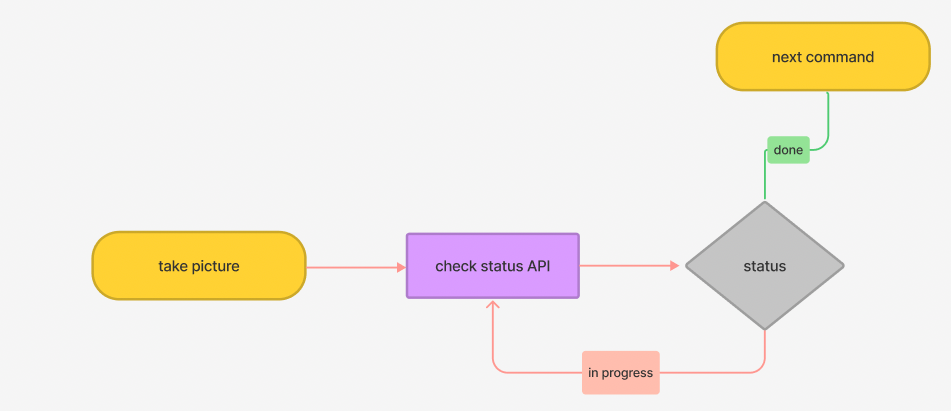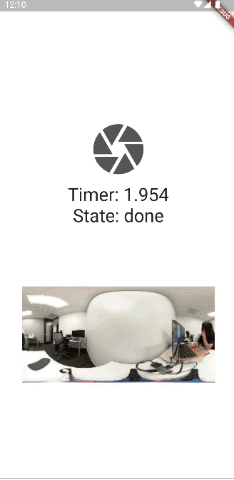06. Multiple RICOH THETA API Commands in Sequence

Overview
The RICOH THETA will take 3-5 seconds after a picture is taken to be ready to take another picture. The time may vary depending on light conditions and filters. For example, using the HDR filter will result in a longer time to be ready. There are many scenarios where the time to execute a command will vary. If the previous command is in progress, then the next command may fail.
This tutorial focuses on taking a picture and then using commands/status to see if the "taking picture" process is "done."
A timer shows the time it takes for the command to finish.

Main Resources
Concepts
The process id is parsed out when the commands/execute is run and then emitted to the state of the camera. Once the state is updated, the id is passed into the commands/status since it's a required parameter for the command to run.
Steps
- take picture with commands/execute
- get command "id" of commands/execute https://github.com/ricohapi/theta-api-specs/blob/main/theta-web-api-v2.1/protocols/commands_execute.md

- using commands/status and the "id", get the "state" of the camera, either "inProgress" or "done"
- The
/commands/statuscommand needs to be in a loop with a delay between calls to/commands/status. One way to add a delay in Dart is to useFuture.delayed()- exampleFuture.delayed(Duration(milliseconds: 200)) - set up timer in Dart and start the timer when the takePicture command is run. one possibility is to use Stopwatch class in Dart. https://api.dart.dev/be/177591/dart-core/Stopwatch-class.html (recommended, but not required)
- display the elapsed time from the point the takePicture button is pressed until the camera is ready.
- when the camera is ready, show camera ready
- leave elapsed time on the screen for reference. Use at least a tenth of a second accuracy
Key Points
- application must check "camera status" to see if camera is ready for the next command. If the camera status is not checked, THETA apps may exhibit unexpected behavior
- using
/osc/statusis a little difficult since the API command requires the "id" of the previous command it is checking on. The developer needs to chain two commands together - the check for
/osc/statusneeds to be in a loop. The developer needs to delay the iteration of the loop so that the camera CPU is not overloaded
Measuring time for process to complete
To measure the time and display it on the screen, the application uses the Stopwatch class. Inside of the CameraUseState file, a variable called elapsedTime records the time that has passed on the stopwatch. When the user presses the takePicture button, the stopwatch is started in the TakePictureEvent.
stopwatch.start();
A while loop continously adds the CameraStatusEvent to the TakePictureEvent until the image is done shooting or state.cameraState equals done. The delay is neccessary to give enough time for the state of the camera to change. Thus, the elapsedTime variable is updated every 200 milliseconds and the UI changes in tandem.
while (state.cameraState != "done") {
add(CameraStatusEvent());
await Future.delayed(Duration(milliseconds: 200));
emit(CameraUseState(
id: id,
message: response.bodyString,
elaspedTime: stopwatch.elapsedMilliseconds.toDouble(),
cameraState: state.cameraState));
}Outside of the while loop, once the camera is finished taking the picture, the stopwatch is reset.
stopwatch.stop();
stopwatch.reset();Response Window
Similar to previous apps, the thumbnail is inside of a ternary operator and is shown if the cameraState equals done and there is a fileUrl. The thumbnail image is wrapped with an InkWell widget that routes to another screen when pressed. This screen shows the image in full view using the Panorama package, also found in a previous tutorial.
state.cameraState == 'done' && state.fileUrl.isNotEmpty
? InkWell(
onTap: () {
Navigator.push(
context,
MaterialPageRoute(
builder: (context) => FullImageScreen(
fileUrl: state.fileUrl)));
},
child:
Image.network('${state.fileUrl}?type=thumb'))The ternary operator is a nested ternary operator. If the cameraState is not equal to done it checks if the cameraState is equal to inProgress. It returns a loading widget from SpinKit if true. Else, the response displays a Container widget.
: state.cameraState == 'inProgress'
? SpinKitFadingCircle(
size: 100.0,
color: Color.fromARGB(255, 208, 206, 206),
)
: Container()Here is a test image taken with the application: